In addition to checking the strength of the antifreeze, a cold-weather starting inspection should also include testing and visually inspecting the battery and cables, starter, alternator and changing to the auto manufacturer’s recommended engine oil.
THE EFFECTS OF COLD WEATHER
Because cold weather slows down the chemical reaction between its electrolyte and its battery plates, the average battery can lose more than 50% of its cranking amperage at 0° F. For that reason, cold-weather starting quickly separates OE-specification from non-OE-specification batteries.
The next cold-weather issue is the viscosity of engine oil increasing at low temperatures. Unfortunately, many shops and motorists still think that thick, gooey oil lubricates much better than the “thin” 5w-30, 5w-20 and 0w-20 oils. Conventional 10w-30 oil usually pours like maple syrup after it’s been chilled to sub-zero temperatures. For that reason, thick oil causes hard-to-diagnose cold starting complaints because it increases the load on the starter and battery.
In other cases, the combination of an under-capacity battery and high cranking torque reduces battery terminal voltage below the 10 volts generally needed for the PCM to activate the ignition and fuel systems. So don’t underestimate the importance of meeting OE specifications when choosing batteries and engine oils.
RECORD KEEPING
It’s helpful to the selling process if a shop develops a database indicating failure patterns for batteries, starters and alternators. Because some nameplates develop predictable failures at predictable intervals in their starting/charging systems, it’s entirely possible to base a repair recommendation on the projected life of the component.
Routine testing, which is the only way to find marginal starting-charging system components, has been made much easier with modern conductance-style starting/charging system analyzers. Through routine testing, a shop might find, for example, that battery failures occur after three to six years of use. Because exposure to heat and vibration generally reduces battery life, some commercial applications might see more frequent failures. With testing in mind, let’s look at how the condition of modern starting/charging systems can be routinely evaluated.
THE POWER OF OBSERVATION
Nothing beats the power of observation for selling batteries. Because heat increases the chemical activity of the battery, it tends to boil off water and corrode the terminals at a faster rate. If the top of a battery has a “wet” look and the terminals are severely corroded, the battery might have a bad cell or the alternator might be over-charging it. On older vehicles, multiple burned-out headlamps and exterior lights are symptomatic of an intermittent overcharging condition.
If the battery appears “too clean,” its plates might be sulfated due to short-trip driving or long-term storage. Because sulfation reduces the electrical storage capacity of the battery, discharging and recharging very quickly is symptomatic of a sulfated battery. In addition, loose or missing battery hold-downs vastly accelerate mechanical wear on the battery plates by allowing the battery to vibrate on rough road surfaces. Last, always check the installation date on the battery. If the battery is more than five years old, it is probably reaching the end of its useful service life.
BATTERY RATINGS
The primary job of the battery in a modern electronic vehicle is to maintain the voltage needed during cranking to operate on-board electronics. Most modern batteries are rated in Cranking Amperage (CA) and Cold Cranking Amperage (CCA). Keep in mind that CA ratings are the higher value because they’re rated at 70° F temperature. CCA ratings are lower because they’re rated at 0° F temperature. A battery rating of 500 CCA indicates that the battery will produce 500 cranking amps at 0° F temperature while maintaining at least 9.6 volts (preferably 10 volts) at the battery terminals to power system electronics.
BATTERY TESTS
Conductance, carbon pile loading and specific gravity testing are three basic methods of testing a flooded or wet-cell battery for a battery’s state of charge (SOC) and state of health (SOH). Because of its comprehensiveness, simplicity and safety, the preferred method of evaluating battery SOC and SOH is conductance testing.
Because conductance testing passes a small alternating current through the battery plates to measure plate resistance, conductance testing can be used to evaluate batteries that are partially discharged. When performing any conductance test, remember that test results are based upon a battery core temperature of 77° F. If the initial test fails, most conductance testers will request a corrected cold-soak or core temperature.
Conductance testing might also be combined with load testing and specific gravity testing. Load testing with an adjustable carbon pile generally requires that the battery be fully charged and at room temperature. Most batteries are load-tested at one-half the cold cranking amperage (CCA) rating for 15 seconds with a good battery maintaining at least 9.6 volts at the terminals during a load test. When load-testing a battery, follow the equipment manufacturer’s instructions and work in a well-ventilated area to prevent a possible battery explosion.
Specific gravity testing can be used on a battery with removable cell caps and can also be dangerous because electrolyte can be splattered into the eyes or contact the skin. The specific gravity of a fully charged battery should range between 1.250 and 1.270, with a variation of no more than 0.050 between cells. A partially discharged battery will have the highest and lowest specific gravity at the positive and negative terminals, respectively. Specific gravity tests are most useful for locating bad cells in new and old batteries.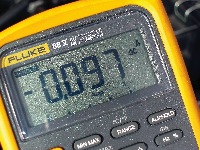
AGM-VLRA BATTERIES
Some auto manufacturers are now installing absorbed glass mat (AGM), valve-regulated lead acid (VLRA) batteries. The advantage of AGM batteries is a more compact design and no acid leakage in case of an accident. The valve-regulated feature allows the release of excess gas pressure if the battery is over-charged. Be aware that some manufacturers recommend special charging and testing equipment for AGM batteries. If you’re dealing with an OE AGM battery, check your service information for recommended testing and charging procedures.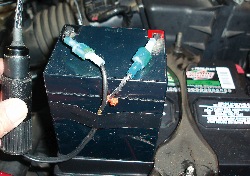
PARASITIC DRAW TESTS
In most cases, excessive parasitic draw runs down a battery if the vehicle is parked at least 3-5 days. Excessive parasitic draw is generally caused by interior lighting remaining on, modules not timing out correctly and poorly engineered aftermarket electronics. While modules on most vehicles time out in about two hours, some might require longer periods. Most auto manufacturers now list normal parasitic draws for their various lines. The rule of thumb for parasitic draw is about 20-50 milliamperes (mA) of current with all modules timed out and accessories turned off. See Photos 1, 2 and 3.
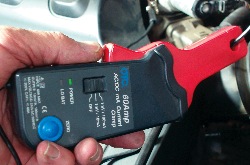
BATTERY REPLACEMENT PRECAUTIONS
Various components and accessories on many higher-end import vehicles might require an extensive relearn process if the battery is disconnected. OE or OE-equivalent scan tool equipment might be required to perform the relearn processes. Occasionally, it’s possible to keep the vehicle electronics powered with an auxiliary battery while the starting battery is being replaced. Whatever the case, it’s important to familiarize yourself with the vehicle you’re servicing via an aftermarket or OE service information system.
ALTERNATOR TESTS
Conventional configuration alternators are most effectively tested with an adjustable load, carbon-pile tester that allows the technician to test drive belt slippage and output amperage. With no load, a conventional charging system should produce 14.2 volts at the battery terminals at room temperature. To compensate for temperature-related chemical activity, the charging voltage might rise to 15.2 volts during extremely cold temperatures and drop to 13.8 volts at above-normal temperatures.
On modern vehicles, the charging rate of the alternator is controlled by programming in the PCM that monitors vehicle electrical load and battery state of charge. For this reason, I would hesitate to recommend any “generic” method of testing these charging systems. So, before condemning any alternator for what appears to be a low charging rate, it’s always best to review the service information applicable to the vehicle being serviced. In some applications, alternator failures can be better evaluated by scanning for trouble codes using a professional-grade scan tool with a comprehensive data stream and bi-directional features.
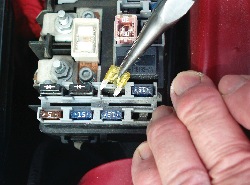
STARTER TESTING
In years past, the rule of thumb for testing starters was that the cranking amperage should equal approximately one-half of the cubic-inch displacement of the engine. But, since the introduction of smaller engines and compact permanent magnet, reduction-gear starters, this rule has largely gone by the wayside. In my experience, most of the complaints related to permanent magnet starters are engagement issues that involve the transmission range sensor, starter relay, starter solenoid or starter drive gear components.
It’s also important to remember that the starter engagement on many late-model applications is commanded, not by the starter switch on the steering column or instrument panel, but by the PCM. Once in a great while, a “weird” starter problem might be caused by a cracked field magnet in the starter itself. See Photos 4 and 5. 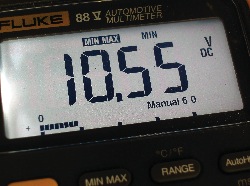
It’s most important to record the terminal voltage at the battery during cranking. Remember that the battery should maintain at least 10 volts at its terminals during cold-weather cranking. Because many cranking speed problems are caused by corroded terminal connections, it’s important to include clean battery terminals as a routine service procedure. It’s also important to check the battery connection at the starter solenoid for looseness or corrosion.












